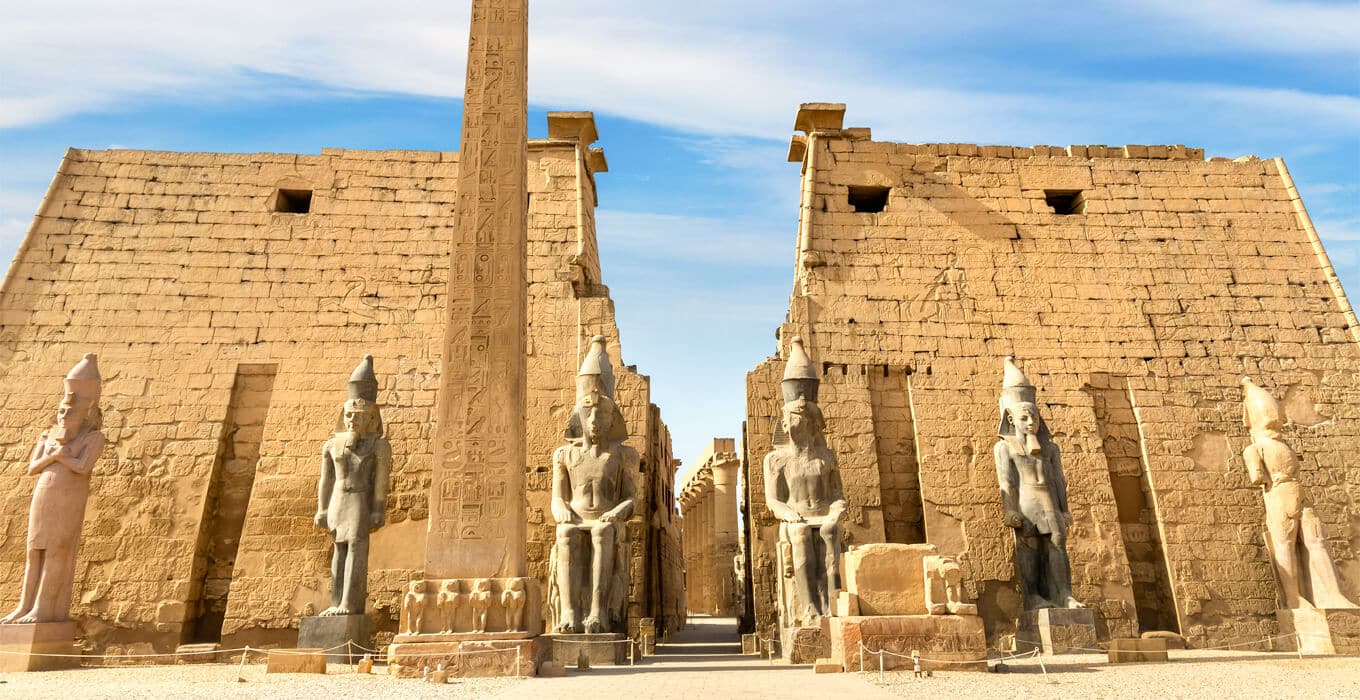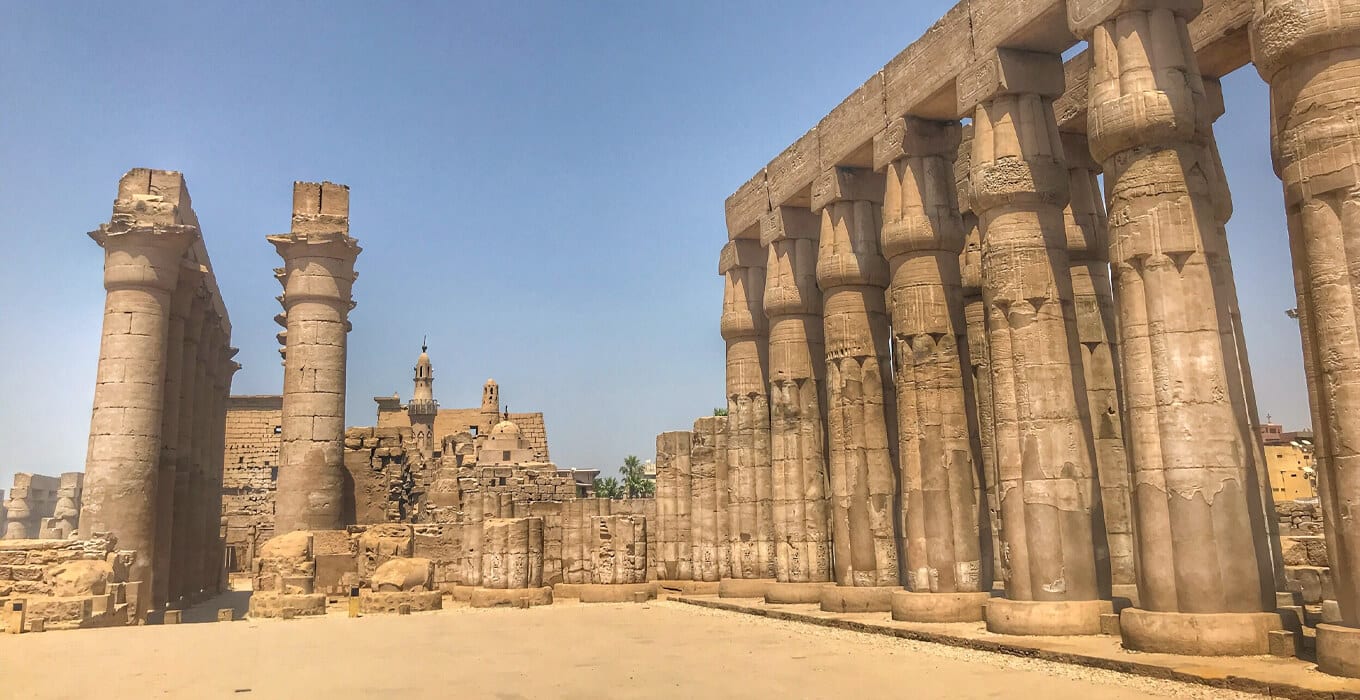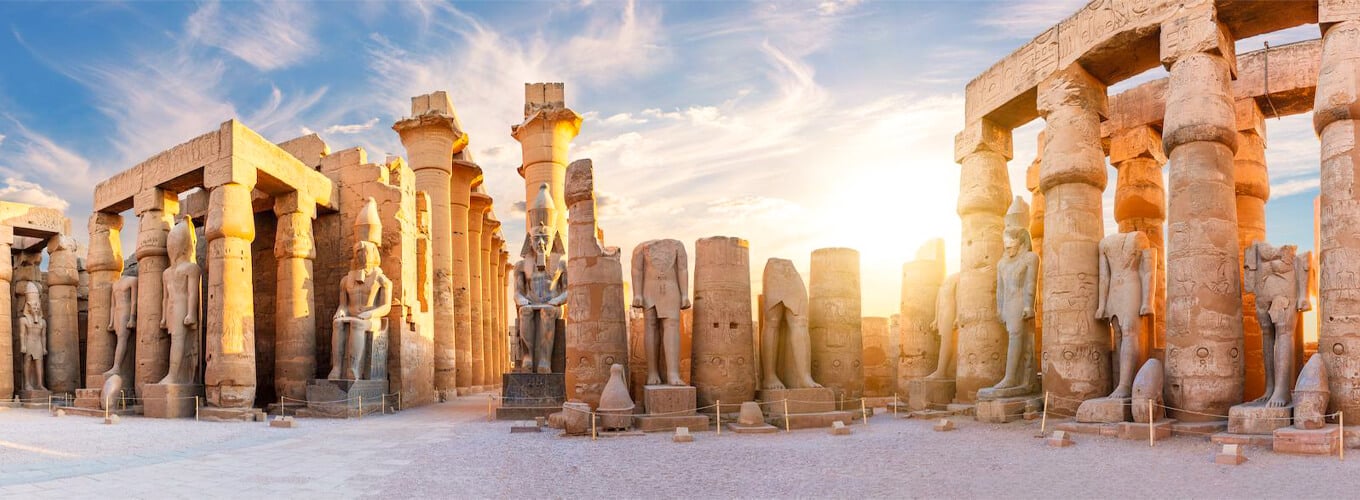The Luxor Temple sits by the Nile River in Thebes, now known as Luxor. It’s a huge ancient Egyptian temple. It shows the skill and faith of the pharaohs who built it during the New Kingdom.
This temple honors the gods Mut, Khonsu, and Amun-Ra. It was key in the Opet Festival, a big religious event. Here, statues of these gods were moved from the Karnak Temple.
The temple’s big entrance is 61 meters wide. It leads to amazing sights like detailed carvings, big statues of Pharaoh Ramses II, and the Great Colonnade. Amenhotep III added this during his rule.
Key Takeaways
- Luxor Temple is one of the largest and best-preserved ancient Egyptian temples, covering an area of over 7,390 hectares.
- The temple was dedicated to the Theban Triad of deities – Mut, Khonsu, and Amun-Ra – and was the main venue for the important Opet Festival.
- The temple’s architecture features a massive 61-meter-wide entrance, towering statues of Ramses II, and the impressive Great Colonnade added by Amenhotep III.
- Luxor Temple’s history spans millennia, with the site transitioning from an ancient Egyptian structure to a Roman fortress, Christian church, and eventually a mosque.
- The Luxor Temple complex, along with other archaeological sites in Thebes, was inscribed as a UNESCO World Heritage Site in 1979.
The Grandeur of Luxor Temple
Luxor Temple is a stunning monument in the heart of ancient Thebes, now Luxor, Egypt. It shows the amazing skill and deep faith of the ancient Egyptians. The temple took many years to build, with help from pharaohs like Amenhotep III, Tutankhamun, and Ramesses II.

Construction and Significance
Pharaoh Amenhotep III started building Luxor Temple around 1400 BCE. Later, other rulers added to it. It was a key place for religious events, royal events, and festivals in the New Kingdom.
It was important for the Theban Triad – the gods Amun, Mut, and Khonsu. The temple was also where pharaohs were reborn in a special ceremony during their coronation.
Architectural Highlights
The Luxor Temple has an amazing design. It has the Great Colonnade Hall with 28 tall columns. Tutankhamun finished decorating it around 1330 BCE, showing off the skill of ancient Egyptian artists.
The temple has statues of Ramesses II and Amenhotep III. There are also detailed wall reliefs that show Egyptian life, myths, and rituals.
Luxor Temple still amazes people from all over the world. It lets us see the deep culture and faith of ancient Egypt.
Luxor Temple in Egypt: A Marvel of Ancient Architecture
The ancient Egyptians built amazing temples, and the Luxor Temple is a top example. It dates back to around 1400 BCE. It was built on the east bank of the Nile River in Thebes, now known as Luxor.
This temple is huge, full of detailed decorations, and has a rich history. It shows the skill of Luxor Temple architecture and ancient Egyptian temples.
The Luxor Temple was for the gods Amun-Ra, Mut, and Khonsu. Building started during Amenhotep III’s rule and went on through other pharaohs like Tutankhamun and Ramses II. Many people came from Thebes and around for big religious events.
|
Architectural Highlights |
Significance |
|
Hypostyle Hall with Towering Columns |
The hypostyle hall at Luxor Temple is known for its tall columns with beautiful designs. |
|
Colonnade Entrance |
The entrance has big columns with detailed carvings and writings. |
|
The Birth Room |
This room shows the birth of Amenhotep III in a special way. |
Luxor Temple is near other important sites like the Karnak Temple and the Luxor Museum. This makes it a key place to learn about ancient Egyptian temples by the Nile River. It has been used for many years, even after the ancient times. This makes it a unique and interesting part of Egyptian history.
Unveiling the Mysteries of Luxor Temple
Luxor Temple in Egypt is full of ancient wonders. Every corner holds secrets. The divine birth scenes on its walls are especially fascinating. They show how the king’s true father was the god Amun-Ra, who looked like Thutmose IV.
The Divine Birth Scenes
The divine birth scenes at Luxor Temple are a peek into ancient Egyptian beliefs. They show how the king was seen as a god on earth. Amun-Ra, the king of gods, is central in these scenes.
The Great Colonnade
The Great Colonnade at Luxor Temple is a sight to behold. It’s a 61-meter-long hall with 28 huge columns. Tutankhamun, the young pharaoh, helped decorate it. This place shows the skill of ancient Egyptian architects and artists.
The Opet Festival: A Grand Procession to Luxor Temple
Luxor Temple was the heart of ancient Egypt’s big religious event – the Opet Festival. This big event moved the cult images of the Theban Triad from Karnak to Luxor Temple. The Theban Triad includes Amun, his wife Mut, and their son Khonsu.
The Opet Festival started in the 18th Dynasty of the New Kingdom. It was first celebrated for 11 days under Thutmose III. Later, it lasted 24 days under Ramesses III and 27 days by the end of his rule.
The festival happened in the second month of the Akhet season. This was when the Nile’s floodwaters made the land fertile again. The procession was over 2 km long. It had sailors, soldiers, officials, governors, and priests, all celebrating the deities and the king.
The Karnak and Luxor Temples were key to the festival. They were built as early as 1970 BC. The festival’s beauty and importance are seen in the temples’ walls. These walls show the Opet Festival’s rituals and processions.
Today, the Opet Festival’s spirit is alive again. The reopening of the Rams Road will make Luxor a top tourist spot. It will show the lasting impact of this ancient Egyptian tradition.

Pharaohs and Their Contributions to Luxor Temple
Luxor Temple was built by many Luxor Temple pharaohs over time. Amenhotep III, Tutankhamun, Horemheb, and the famous Ramesses II were some of them. They all left their mark on this famous place.
Amenhotep III’s Core Temple
Amenhotep III built the main part of Luxor Temple during the 18th Dynasty. He started building around 1400 BCE. His work set the stage for what later pharaohs would add.
Ramesses II’s Additions
The great Ramesses II made big changes to the temple. He added a beautiful courtyard and a huge entrance. He also put up two giant obelisks, one of which is still there today.
Pharaohs like Tutankhamun and Horemheb also played a part in the temple’s history. Their work made the temple even more special during the New Kingdom era of ancient Egypt. Together, they turned the temple into the amazing place we see now.
Conservation Efforts: Preserving Luxor Temple’s Legacy
Luxor Temple in Egypt is a wonder from ancient times. It faced many challenges to stay safe over the years. The World Monuments Fund started a big project in the early 2000s. This was thanks to the Robert W. Wilson Challenge to Conserve Our Heritage.
This project worked on over 1,000 blocks and wall pieces that were falling apart. It stopped the damage and started fixing things. This work helped keep the temple safe for people to see and learn from in the future.
|
Year |
Conservation Effort |
Funding Source |
|
Early 2000s |
Consolidation and treatment of over 1,000 deteriorating blocks and wall fragments |
Robert W. Wilson Challenge to Conserve Our Heritage |
|
2008-2018 |
Conservation of the New Kingdom-period Khonsu Temple in Luxor’s East Bank |
United States Agency for International Development (USAID) |
|
2021 |
3D digital capture of the Khonsu Temple, including orthophotographic and CAD outputs |
CPT Studio Roma |
|
2022-2023 |
Fine conservation of the columns, ceilings, and walls in the north-west section of the Khonsu Temple’s first court |
USAID |
These efforts have been key in saving the Luxor Temple. They show the beauty and skill of ancient Egyptian builders. By fixing and rebuilding damaged parts, we keep this treasure safe for all to enjoy.
Luxor Temple’s Enduring Significance
Luxor Temple in Egypt is known for its deep meaning and knowledge about ancient Egyptian life. R.A. Schwaller de Lubicz, a philosopher and Egyptologist, studied it for 12 years. He saw it as an “architectural encyclopedia” that shows the high knowledge and skills of the ancient Egyptians.
Schwaller de Lubicz’s work shows how important the temple is. It proves the ancient Egyptians were very smart and creative. Luxor Temple’s design and symbols show their deep knowledge in astronomy, math, and engineering.
Architectural Encyclopedia of Ancient Egypt
The Luxor Temple complex goes back to the Eighteenth Dynasty (c.1550-1295 BC). Pharaoh Amenhotep III started building it. Later, Ramesses II added more, making it even more special.
This temple is special because of its design and its link to the Karnak Temple. It also has the Abu Haggag Mosque nearby. As a UNESCO World Heritage site, Luxor Temple draws visitors worldwide. It shows the advanced knowledge and skills of ancient Egyptian civilization.
Exploring Luxor Temple: A Journey Through Time
Visitor Information and Tips
Luxor Temple is a must-see in Egypt. It lets you dive into ancient Egyptian culture and architecture. It’s near the famous Karnak Temple and was once connected by a path of sphinxes.
At the temple, you’ll see huge columns and detailed carvings. You can also explore the Theban Necropolis and other ancient sites. The best time to visit is from October to April, when it’s cooler.
Here are some tips for visiting Luxor Temple:
- Luxor has over 60 royal tombs in the Valley of the Kings. It’s a chance to learn about ancient Egyptian pharaohs.
- Be ready to buy tickets for the archaeological sites in Luxor.
- You can get around Luxor by taxi, bike, or carriage. This lets you see the city at your pace.
- For a beautiful view, take a felucca ride on the Nile River.
- You can take photos in most places, but don’t use flash in the tombs. Some spots might need a special ticket for photos.
Luxor offers a journey through ancient Egyptian history. You can explore Karnak Temple, Luxor Temple, and the Theban Necropolis. It’s an unforgettable experience.
|
Tour Package |
Price |
|
10-Day Wonders of Egypt & Cruise on Nile |
$2,490.00 |
|
8-Day Cairo, Alexandria, and Nile Cruise Tour |
$1,740.00 |
|
5-Day Cairo and Luxor Tour |
$1,230.00 |
For a great stay, check out these top hotels in Luxor. The Al Moudira Hotel is known for its beautiful design. The Hilton Luxor Resort & Spa has a great infinity pool. The Nefertiti Hotel is a good choice for those on a budget.
Conclusion
The Luxor Temple is a top example of ancient Egyptian architecture and religious importance. It was built over many years by Pharaohs of Egypt. Its huge size, detailed designs, and deep history make it a wonder of the old days.
It played a big part in the Opet Festival and is seen as an “architectural encyclopedia” of ancient Egyptian knowledge. The Luxor Temple still amazes and motivates those who visit. They come to see its lasting legacy and learn about the old civilization.
The temple is by the Nile River in Thebes. It shows the creativity and vision of the ancient Egyptians. Its big avenue of sphinxes, the Pylon of Ramses II, and detailed carvings are very interesting.
These features make the temple very appealing. People who visit can dive into the rich history and culture of this amazing place. They learn a lot about the architectural and religious achievements of the ancient Egyptians.
The Luxor Temple is a symbol of the rebirth of kingship and the lasting power of the Egyptian gods. It still draws people from all over the world. Its role in worship, history, and as a place of knowledge makes it a key spot for those wanting to see the beauty of Luxor Temple and the lasting impact of ancient Egyptian culture.
Read our related articles:


